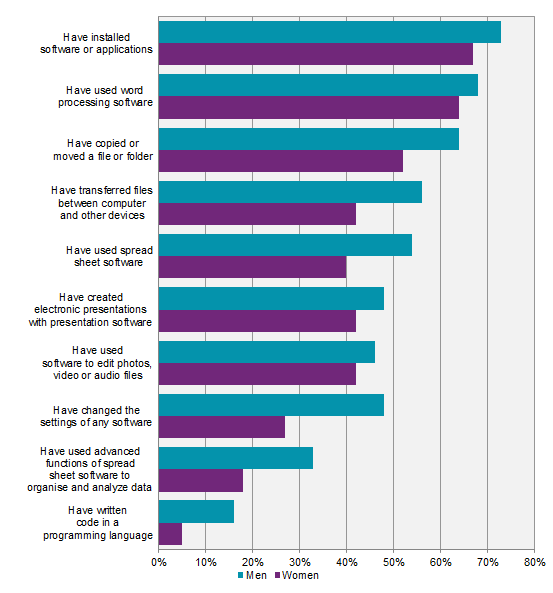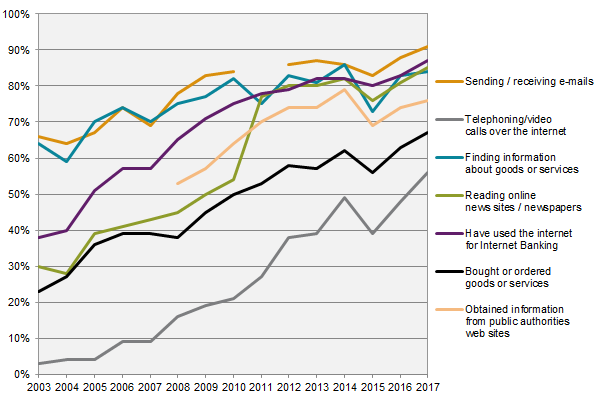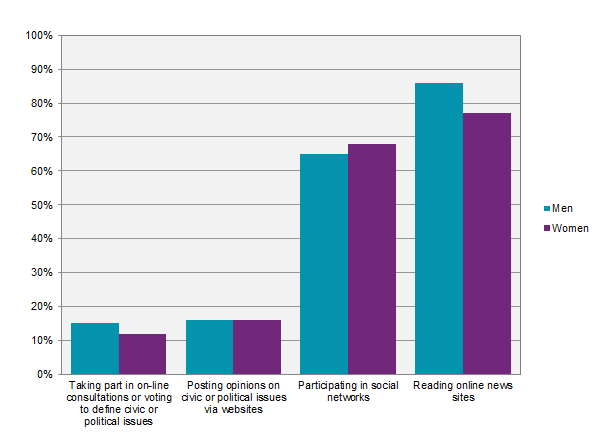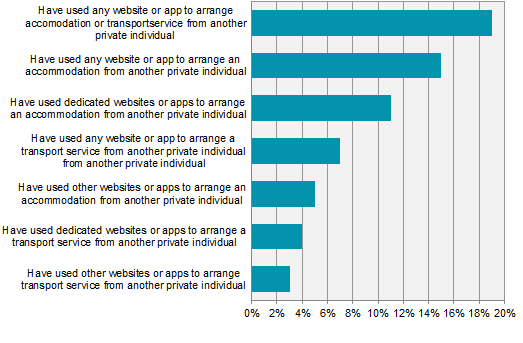ICT usage in households and by individuals 2017:
More men than women are programming
Statistical news from Statistics Sweden 2017-12-01 9.30
This year's survey on ICT usage in households and by individuals shows that the proportion of women who have programmed is still significantly lower compared to men. Nearly three times as many young men as young women have written code in a programming language.
Digital skills
As society becomes more and more digitalized, skills in this area become more important. The results from this year's survey show that approximately 70 percent of the population aged 16-85 had installed software or apps and that approximately equal shares had used word processing software. About 45 percent had edited images, video and audio files, and about as many had created digital presentations with images, charts and tables. There are no, or very small differences between men and women for these areas of digital skills.
For digital skills such as programming, using advanced features in spreadsheets, or changing settings in software, significant gender differences exist. For example, 16 percent of men had written code in any programming language, while only 5 percent of women had done this.

Access to the internet
Access to the internet at home is widely spread in Sweden. Of the population aged 16-74, 96 percent had access to the internet at home in some form. The average for the rest of Europe in 2016, which is the most recent data, was 85 percent. This year's survey also shows continued large differences between the generations. Of those aged 16-54, 98 percent had access to the internet at home, while the corresponding share in the age of 75-85 was 61 percent.
The most common internet connection used at home was via a fixed broadband connection. In total, close to 80 percent in the ages of 16 and 85 connected to the internet via fixed broadband connections. Connecting to the internet away from home with a mobile phone or a smartphone has become much more common during the last six years. This year's survey also shows that this is roughly equally common across the country. Of those aged 75-85, however, only 20 percent have used a smartphone to connect to the internet outside of home, compared to 84 percent for those aged 16-74 years.
Use of the internet
In total, 17 different activities on the internet were mapped in this year's survey. The most common activity was to send or receive e-mails, which 87 percent in the age of 16-85 had done. Reading or downloading e-newspapers and news sites belongs to one of the uses that has increased sharply in recent years. During the first quarter of the 2016, 81 percent of the population aged 16-85 years had performed this activity, compared to 54 percent in 2010.
As for e-commerce, another surveyed area, more people sought information about goods and services than ordered them. During the first quarter of the year, 63 percent of the population aged 16-85 had bought a product or service over the internet, while 80 percent had sought information about goods or services over the internet.

Digitalization of the public sector
In parallel with the fact that society is becoming increasingly digitalized and that more and more people use the internet, the public sector has also provided certain services via the internet. An important indicator regarding the public sector's transition towards an increased digital maturity is the proportion of the population who had submitted completed forms over the internet to any authority. This may for example be submitting the tax declaration, apply for student funds, parental allowance, sickness compensation, or something else. This year's survey shows that 68 percent of the population aged 16-85 had done this.
In an international comparison, the results of the year's survey show that digitalization has come a long way in the public sector in Sweden. In Europe, the average proportion of the population who had submitted completed forms via the internet was 27 percent in 2016, which is the most recent data available. The corresponding share in Sweden this year was 72 percent.
E-democracy and on-line news
Internet use has gained increased attention and importance in recent years. This year's survey on ICT usage in households and by individuals shows that just over 80 percent of the Swedish population aged 16-85 had used the internet to read news on news sites, two out of three had used social networking sites, 13 percent had taken part in on-line consultations or voting to define civic or political issues and 16 percent had posted personal opinions on civic or political issues via websites. Throughout these activities, the younger ones are significantly more active.

Sharing economy
New for the year's survey were questions about participation in the so-called sharing economy, where a growing proportion of internet users have made it easier for people to find each other to share assets and services.

The extent of the sharing economy in Sweden has, in this year’s survey, been limited to accommodation and car transportation. Results show that close to one in five people of the age 16-85 have used the internet to arrange accommodation or car transportation from another private person over the internet during the last year, either via a dedicated website or app such as Airbnb, or from a more general site or app such as Facebook or Blocket. Finally, the results show that men arranged accomodation or car transportation over the internet to a greater extent than women.
Next publishing will be
2018-11-30 at 09:30.
Statistical Database
More information is available in the Statistical Database
Feel free to use the facts from this statistical news but remember to state Source: Statistics Sweden.
